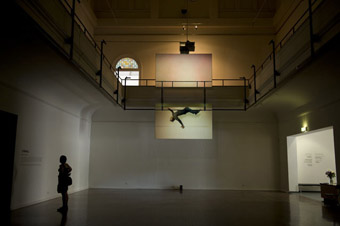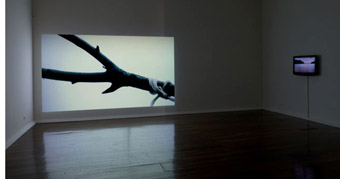retooling modernist tropes
darren jorgensen: dominic redfern, pica
One of the legacies of modernism is a collection of established tropes that performers can dip into and retool to their liking. The video installations of Dominic Redfern recycle some of these tropes to affect an instant replay of the heroism of the modern man.
In massive screens attached to either end of the Perth Institute of Contemporary Art’s central gallery, Stonewall (2008) shows Redfern climbing the rocky slope of a hill above Queenstown, Tasmania. Here copper tailings have poisoned the landscape, producing an apocalyptic environment. This devastated scene offers the artist a site to stage a parody of romantic modernism. As he climbs, Redfern recites a stream-of-consciousness prose piece that recalls the parodies of late modern literature, by such French authors as Blaise Cendrars and Raymond Roussel. These writers are famous for playfully reworking the tropes of romantic literature to create abstract, meaningless machines of novels. They pastiche the classic ‘quest’ structure of the novel into a pointless, ridiculous escapade. The ghosts of Cendrars and Roussel linger in Stonewall as a recording of a French translation of Redfern’s monologue plays in the background, lending a Francophone cultural credibility to the piece. As Redfern writes, Stonewall is “promising significance yet consistently failing to deliver closure” (artist statement, www.dominicredfern.net).

Stonewall 2008-09, Dominic Redfern
photo by Eva Fernandez, courtesy of PICA
Stonewall 2008-09, Dominic Redfern
It is between the tragedy of the masculinity on show and the comedy of its repetition that we can locate the other video pieces in the show. As a part of a series of video installations called Mythos (2007-9), Redfern is videoed walking across a salt lake, and on another screen wanders amongst grass trees, as if to mimic the loss of the modern artist in the vast Australian continent. In a piece called Emerge, again a part of the Mythos series, he surfaces from under the water of a magnificent European mountain lake. Walking onto shore, dressed in a soaking pair of jeans and a t-shirt, he picks up a branch before wandering out of shot. Once again the performance makes banal the tales of modernity, this particular tale located somewhere between Charles Darwin’s theory of evolution and Stanley Kubrick’s 2001 (1968). As Redfern occupies the place of the heroic modern protagonist, and performs a man who finds nothing at the end of the existential rainbow, his piece recollects the absences of art after modernism.
The French philosopher Jean Baudrillard has claimed that there can be no art after the Modern had exhausted the quest for art, and that contemporary art only occupies the place of an art that has in postmodern times disappeared. Redfern occupies the place of the artist in the absence of art, playing out the heroism of making an art that is not really there. He makes a tragic figure, who can only redeem himself through simulation and, like these late modern writers, parody. So it is, that the other screens of Stonewall, at the opposite end of PICA’s massive gallery, intermittently show a cardboard cutout image of Redfern falling, as if he has lost his grip on the side of the mountain. The flatness of this image renders the masochism of the solipsistic male an image like any other, to be retooled and repeated, pointlessly, by contemporary art.
Mythos 2008-09, Dominic Redfern
photo by Eva Fernandez, courtesy of PICA
Mythos 2008-09, Dominic Redfern
Dominic Redfern, Perth Institute of Contemporary Art, Perth, 31 Oct-20 Dec, 2009
RealTime issue #93 Oct-Nov 2009 pg.






